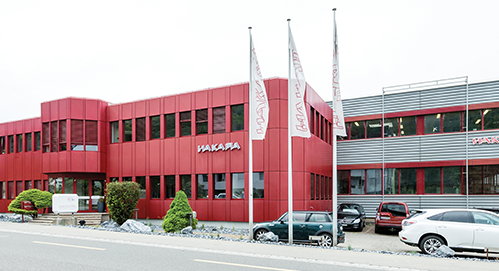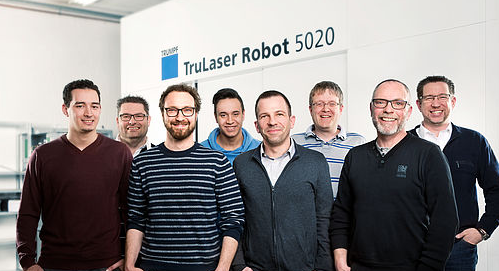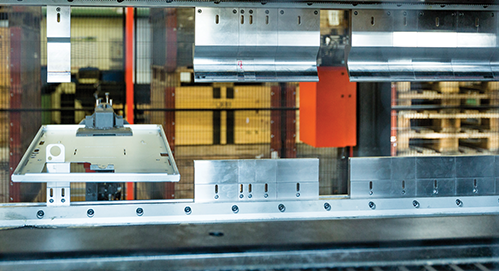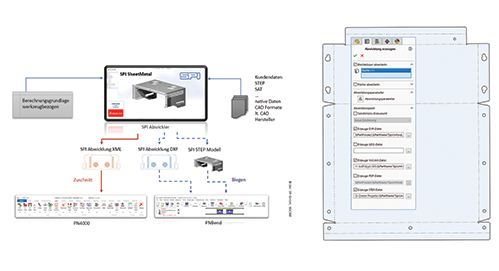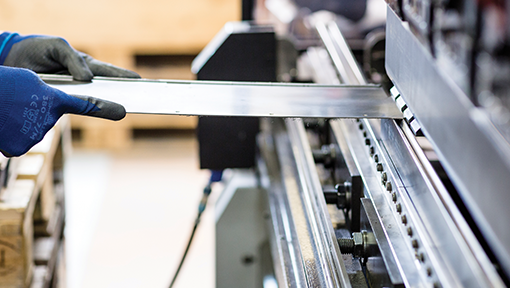
Industry insiders know: the resounding name of the Swiss sheet metal specialist was coined by the company’s founders Othmar Haberthür and Ernst Kasper. In 1956, they founded their joint company near Mariastein in the Swiss canton of Solothurn and named it HAKAMA.
In the seventies, the successors Marius Haberthür and Fritz Kaspar took over the management and paved the way for HAKAMA to become a development partner for specialty equipment, initially in the pharmaceutical industry and electronics. With the advent of computer controls in sheet metal processing, the company’s machinery was modernized accordingly. 17 of today’s 40 press brakes are CNC controlled and supplemented by an Amada press brake robot. In 2010, INDUS Holding AG joined the company and became the sole owner of it in 2013, ensuring that HAKAMA is financially secure for all future challenges.
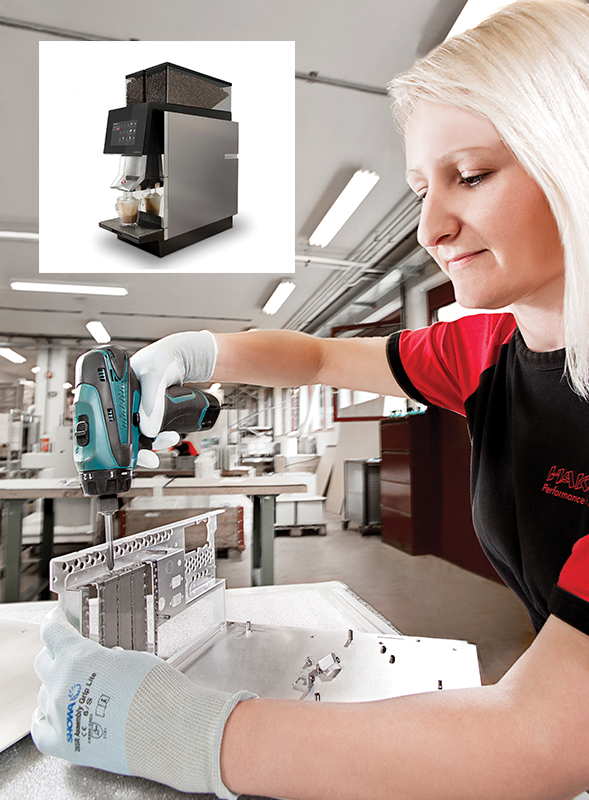
By now, with Claude Kasper, already the third generation is involved in the business. “HAKAMA positions itself in the European market as a leading and innovative solution provider in the thin sheet metal sector“, emphasizes Kasper. “At HAKAMA you will find a network with solid expertise, supported by state-of-the-art technology. We offer our long-standing industry know-how, a wide range of services, international presence, and new ways of doing things – factors that enable our customers to successfully compete in the global marketplace,” says the Head of Marketing and Sales, summarizing the company’s present standards.
From Metal Spinning to Thin Sheet
The former metal shop for household appliances has developed into sheet metal expert and housing specialist,whose customers are now primarily found in the fields of medical technology, laboratory measuring technology, food technology, and aviation. “We deliver innovative design for high-end requirements,” confirms Thomas Seper, Head of Engineering at HAKAMA. “With our interdisciplinary know-how, with state-of-the-art technologies, and highly motivated experts, we support international and national companies in the industrialization of complex commodities,” Seper continues. “In doing so, we keep an eye on the actual application. Above all, I see us as the customer’s industrialization partner: from the idea to series production and application.”
“Our professional project management is a link between the experts and the project managers internally as well as externally, that is, on the customer side. This way, we can ensure an effective procedure even when there is a large number of variables in different projects. And we always keep in mind also the benefit and the practical value of the object.”
High-precision housings, assemblies, innovative solutions, in other words, what we usually call “Swiss engineering”, cannot be realized economically with standard software. Just as our customers rely on the expertise and the highest quality standards, we do as well in our design process. With SPI, we have found a professional partner who, for decades, has made a name for themselves as the expert for high-performance sheet metal software.
CAD Software for High Demands
Intelligent design and bending allows the manufacture of products for which, using conventional methods, several parts would have to be produced and then joined subsequently. However, to make that possible, the software must create a manufacturing-ready flat pattern as well as an NC program for the laser cutting or punching machine and for the bending offline programming from the 3D design. Increasing customer demands, as well as the company’s own high standards, led to the conviction that only the best CAD software should be used. Already since 2005 HAKAMA relies on the sheet metal software solution from the North German software expert SPI GmbH, at the time based on the CAD system Mechanical Desktop. In 2008, 10 network licenses were in use. Then followed a period of searching for a parametric 3D successor system, during which also Solid Edge was shortlisted.
After Solidworks finally replaced the existing systems in 2017, the decision was also made for the appropriate additional solution for sheet metal software from the professionals from northern Germany. Today, numerous Solidworks licenses, licenses of SPI Software SheetMetalWorks, and – for the output of the data into the required machine formats – several licenses of the Trumpf and WiCAM interfaces of SPI are available.
“Premium sheet metal solutions for the technology of tomorrow, short response and delivery times, no matter how high the requirements” – this is the postulated vision of the company. “Not only our own but also the customers’ demands have increased over time,” explains Head of Engineering Thomas Seper.
Fully Automatic Coffee Machines for the Catering Industry
“One example of how we put our standards into practice is a fully automatic coffee machine developed for an international company based in Switzerland.” Smiling, the sheet metal professional adds, “As a coffee drinker, it’s almost impossible not to encounter this device in the catering industry.”
An elegant and user-friendly housing for a top model series of coffee machines – that was the core task of the customer, the leading manufacturer Thermoplan. In the hectic catering business, the machines were to offer reliability, appealing design, and maximum usability. Therefore, a solution had to be found for the modular design of the machines that would allow assembly of all components with just one key. Further requirements: exact implementation of the design specifications and conformity to NSF standards. “Only HAKAMA came into consideration for this task: innovative and always with a keen eye for the best solution,” was the decision at Thermoplan.
Outstanding Solution Thanks to Software Application
“Here we have realized an outstanding solution with the customer. The modular design allows the assembly of four different machines, a challenge for our designers that certainly would not have been completed in the allotted time without the SPI software,” summarizes Seper. “With the limited space available for the central unit, our design skills very truly put to test,” recalls Dominique Oudot, who as a product designer played a key role in the implementation.
“We design and develop with the Solidworks professional 3D program, SPI’s sheet metal module, and the SPI add-ins for the output formats that we need for our manufacturing machines.” The company’s manufacturing uses two combined laser punching centers from Trumpf and a laser cutting system from Bystronic.
In this project, very precise fitting accuracy of the individual components was crucial. The calculation of the flat pattern of the 3D objects for the cutting depends on only on the material used, but also on the machines and tools used in manufacturing. “With the software from SPI, we can apply the required parameters already during the design phase, as the exact data is available to us in a database in the background. This ensures that the manufacturing radii and bending factors resulting from the bending process are already taken into account during the design of the parts. In addition, SPI generates for us a WiCAM XML file with the specific content, that can be directly used by WiCAM’s PN4000 for NC code generation and control of various machines. In addition, we receive a STEP file that shows us the part as it will look in reality in its finished state. All in all, it’s process-orientated, consistent, and, above all, error-free.”
Sharp-edged Design, Import Tolerance, and Virtual Prototyping
The SPI software also supports the Swiss sheet metal experts in other projects. Individual parts are created parametrically as a 3D solid body and can be easily modified and adapted. “Since the actual design is often already created by the customer, importing the existing CAD data enables us to shorten the processing time on our end and to ultimately cut down the delivery time,” explains Head of Engineering Thomas Seper. “We also tell this to our customers, to whom we give corresponding instructions on the data formats. But not everyone always adheres to it. It can also happen that the designs have incorrect inner radii, problematic reliefs, and inaccurate bend lines.” In such cases, processing used to lead to many inquiries and unnecessary delays.
HAKAMA now has this issue under control. Efficiency and consistency within the sheet metal process chain have improved considerably since today every part is unfolded with the correct parameters from the material and machine database running in the background. A significant advantage is the tolerance of the SPI software with regard to sharp-edged parts, as well as the SPI functionality of virtual prototyping. Regardless of how a part was designed, after analyzing the data, SPI generates not only the XML file but also a manufacturing-ready STEP file with all the specifically required process information, correct reliefs, forming processes, and punching. This serves as a prototype that shows the part as it will be when manufactured on-site. “Thanks to the integration of the SPI add-ins for the output formats – we use this for our laser and bending machines – we can transfer the data from design directly to production,” sums up Thomas Seper. “A big step forward and a real gain in terms of automation and consistency of our processes.”
The Conclusion
What was the challenge?
For this project very precise fitting accuracy of the individual components was crucial. The calculation of the flat pattern of the 3D objects for the cutting depends on only on the material used, but also on the machines and tools used in manufacturing.
What have you gained?
Since the actual design is often already created by the customer, importing the existing CAD data enables us to shorten the processing time on our end and to ultimately cut down the delivery time.
In a nutshell: the main advantage?
A significant advantage is the tolerance of the SPI software with regard to sharp-edged parts, as well as the SPI functionality of virtual prototyping. Regardless of how a part was designed, after analyzing the data, SPI generates not only the XML file but also a manufacturing-ready STEP file.
What would you like others to know?
High-precision housings, assemblies, innovative solutions, in other words, what we usually call “Swiss engineering”, cannot be realized economically with standard software. Just as our customers rely on the expertise and the highest quality standards, we do as well in our design process. With SPI, we have found a professional partner who, for decades, has made a name for themselves as the expert for high-performance sheet metal software.
Reference as PDF
Here you can download the story, including all images.
Our Products
We help you to streamline your sheet metal process chain.
Our Offer
You would like to try it yourself? Contact us!
And More
Here you can find more references and stories.

